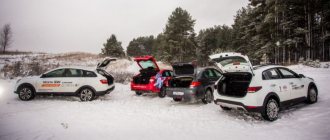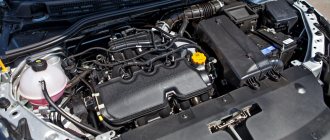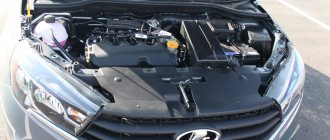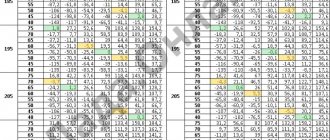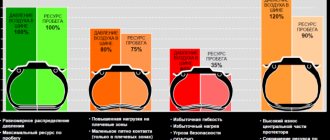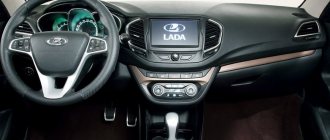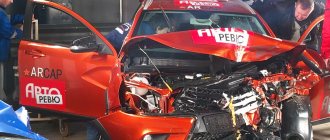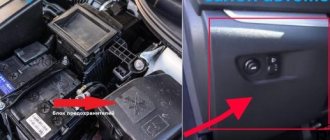The hype around the new product of the domestic automobile industry - the Lada Vesta SV Cross station wagon - has not yet subsided, but there is still not much technical information about the new product on the Internet. In particular, the Lada Vesta SV Cross suspension is on our agenda today.
So many questions about the suspension of the new product arise due to the fact that the suspension design of the Vesta Cross has radically changed compared to its predecessors. At AvtoVAZ it was decided not to follow the old path and not to modernize the obsolete suspension, which had previously been installed on Samaras and Prioras. Instead, a new model was developed, which is now installed on the entire Lada Vesta family. In particular, for the Lada Vesta Sedan, the Vesta SV station wagon and the all-terrain version of the Vesta Cross SV.
Why was the new Lada Vesta SV Cross suspension needed?
Firstly, the old model of the VAZ suspension is outdated both technically and morally. Yes, it was easier and cheaper to assemble a new station wagon suspension using old components, reconfigure it and put it into production. But all car critics would again smash such a decision to smithereens in their reviews and reviews.
Secondly, the new product was made almost from scratch, so new solutions were needed for a more comfortable ride and precise handling. For this purpose, it was decided to develop our own model. Yes, most of the components and solutions in the suspension were copied from foreign cars. But the VAZ team deliberately went this route. Why reinvent the wheel? It is much easier and more correct to take the best from foreign cars and implement it in your car.
Thirdly, the car was designed on a new platform and ready-made solutions from AvtoVAZ would no longer be suitable.
What's the end result? But the end result is a completely tolerable suspension, which is in no way inferior in dynamics, controllability and comfort to its foreign counterparts. Almost all car critics and experts talk about this. Yes, many components and assemblies were borrowed from Renault, but this is not so important. After all, at the end we received a high-quality and reliable product at an adequate price. And in principle, we shouldn’t care what kind of car the parts are from. And now critics will not be able to argue at all that the suspension design has not changed since the days of the G8.
What's new: about built-in technologies and stabilization system
In addition to the Vesta features listed above, it is worth considering a number of other innovations in the chassis, which are no less important. First of all, it is necessary to note the use of systems such as ABS, ESP, and EBD. In addition, the Lada Vesta has power steering from Nissan, and its braking system is equipped with components from Renault Logan and Renault Megane. Acting together, these factors give the car high status and reliability.
The new Lada Vesta has a built-in stabilization and traction control system. The system allows you to easily overcome various skids and drifts of the car while driving.
When the electronics in a car are correctly and professionally configured and are capable of simulating a differential lock, then the vehicle’s cross-country ability significantly improves. The Lada Vesta has just such a system and it is configured really effectively. Now you don’t have to worry about getting into mud, snow, uneven surfaces, or driving off to the side of the road. When the stabilization system is turned on, the Lada goes into all-terrain mode and is able to get out of a difficult situation.
This technology is being used for the first time and, judging by real reviews from car owners, it actually works well and does not fail in difficult conditions.
Front suspension Lada Vesta Cross SV
The front suspension design has undergone a number of changes compared to its front-wheel drive predecessors. Just compare how the suspension has changed:
Firstly, a subframe appeared on Vesta. This is the most important change, since no Russian car had it before. The appearance of a subframe means that the factory thought not only about the technical part, but also about the overall ride comfort. The subframe itself allows you to avoid attaching power units and chassis to the body, and therefore provide additional comfort and improve handling.
Secondly, a new anti-roll bar was used. This added a little controllability, but also allowed the load to be evenly distributed along the entire axle.
Thirdly, the stabilizer is now attached to the shock absorbers using links, which are struts with articulated ends. Previously, Priors and Samaras used “eggs” with rubber bushings. The use of ball ends allows you to improve the car's handling when cornering, thereby reducing roll.
Fourthly, an L-shaped arm was added to the design, which is attached to the subframe at two points. This made it possible to reduce backlash and jerking during acceleration and braking. Thus, in terms of suspension, the result was a well-built and reliable car. And the suspension itself is not particularly loaded and has a large number of parts.
Self-diagnosis of problems
If you don't like the way your vehicle drives over obstacles after a while, or turns into turns less smoothly. First, carry out diagnostics to eliminate other “suspects” and come to the technical center with a clear task for specialists:
- Release the brake pedal. Take the wheel with both hands by the opposite parts and rock it. If a pronounced play is noticeable, this may mean that the problem is in the hub bearing - it must guide the wheel correctly, strictly in one plane; if it is neglected, it can “go figure eight”.
- If the wheel play does not occur due to the hub, then the fault is in the chassis. In this case, play appears even when the brake pedal is pressed.
- If the car “wobbles” in a vertical plane, the stabilizer link is poorly secured or the ball joint is worn out.
- If the car wobbles “horizontally” (push it into the front fender, after tightening the handbrake), it may be that the rod ends have worn out and become unusable.
The design of the front suspension of a front-wheel drive vehicle assumes that all its parts should “age” evenly, almost equally, that is, even if they have different wear patterns, they need to be replaced with new ones in pairs. New components will work evenly, “erasing” from scratch.
Rear suspension of Lada Vesta SV Cross
New solutions were used in the rear suspension of the Lada Vesta Cross, as well as in the front. Although it’s difficult to call it completely new. The entire rear suspension of the car was borrowed from the Renault Megane. In this case, we have a semi-independent suspension, which has been further strengthened, and the track has also been increased. The shock absorbers, as before, are located in cans behind the arches, but the springs have been moved under the side members.
On a simple civilian station wagon there are standard drum brakes at the rear, and on the cross version there are disc brakes. The choice in favor of drums for the simple version is due to the fact that under normal conditions disc brakes are not needed, and drum brakes are in no way inferior to them. And it is more economically profitable to install simple drums than discs. In addition, the drum brake is more protected from dirt, so its service life will be increased.
Initially, the plant considered the possibility of installing rear independent suspension on the Lada Vesta SV, but after preliminary cost calculations they decided to abandon this option. The very fact that they left a semi-independent suspension at the rear suggests that you shouldn’t expect all-wheel drive on Vesta Cross and SV in the near future.
Tuning modification Lada Vesta Cross SW
Vesta Cross is the most interesting option from the entire line. Tuning will improve ride quality, comfort, appearance and generally remake the car to suit you, making it truly unique
But it is important to remember that during modifications the machine may suffer a little, the warranty will be voided and reliability will be lost. For example, when chipping an engine, up to 10% of its service life can be lost
And the work itself can cost up to 150 thousand rubles.
In the “cross” version it is possible to increase the ground clearance. If 203 mm of ground clearance is not enough for you, then you need to make some minor modifications. You can install special spacers – metal plates – under the racks. This will give you a few extra centimeters. It should be noted that different spacers are used for the front and rear struts. You can also reduce the ground clearance using a shortened suspension, in which shock absorbers and springs have been developed. But you won’t be able to cut the springs yourself, since a different suspension design is used.
One of the most popular types of tuning is the development of the “brains” and the engine. Often, reflashing is resorted to due to many shortcomings in the program, however, in more recent models, many of them have been eliminated by the manufacturer. But even after reprogramming such cars, they drive completely differently. Replacing the manifold also helps improve performance. Instead of the standard one, a “spider” is installed, but the Euro compliance indicators drop from the fifth level to the second. In addition, ringing often occurs due to the thin metal of the part, so it is wrapped with thermal tape, but this does not completely solve the problem. As a result, the car starts easier, performs better and becomes more dynamic.
Differences between the suspension of the Lada Vesta Cross and Lada Vesta SV
Many believe that the station wagon and all-terrain versions are not much different. The main differences lie, of course, in appearance. New body kits were installed on the all-terrain version of the Cross, the appearance of the exhaust system was slightly changed, and the interior was slightly redone. However, these are not all the changes.
The most difficult moments concerned the suspension. The fact is that the Cross prefix in the name must be deserved. This is where I had to play around a lot with the suspension. Firstly, the parameters of the wheel inclination angles and castor were reconfigured. Secondly, new shock absorbers were used. Their type has not changed, but their length has increased slightly. The racks have become more rigid and knocked down.
Thirdly, the springs also had to be lengthened. Due to all these manipulations with the suspension units, the car rose by 2.5 cm. In order not to lose stability, it was decided to widen the track by 1.4 cm. All this increased the ground clearance and also improved the handling of the car as a whole.
Trim or install other springs
To cut this at all is some kind of game!
Firstly, there is no 25 cm in a loaded car, which is necessary for comfortable work. Secondly, the work of the suspension will be, on the contrary, torn, and the spring will become a little softer, it simply won’t have enough coils to hold the body normally. The center of gravity of the body will be mixed, which has an extremely negative effect on handling. If you cut off more turns, you will hit the bottom on the road, because again there is not enough spring (let’s say power) to hold the body. YES, the spring can simply fly out of its place.
Install other springs. Hypothetically, this is possible, but they are selected together with shock absorbers (more on this below). But if you make it more powerful, the car will become stiffer, but we need comfort. And if you install it softer than what you had, then the body simply won’t hold up, there will always be breakdowns.
Suspension problems Lada Vesta SV Cross
At the moment, it’s too early to talk about any reliability and service life of the Lada Vesta SV Cross suspension - the cars have not been used for too long. But some conclusions can be drawn.
Based on independent tests by enthusiasts, automotive publications and auto clubs, it can be understood that the Lada Vesta Cross’s suspension still has weak points. Firstly, during intensive use on uneven roads, shock absorbers begin to leak already at 25-30 thousand kilometers. Secondly, the silent blocks on the rear beam become unusable after 20 thousand kilometers. Thus, you can consider them a normal consumable and change them after two oil changes. Although the factory stated that the suspension on Vesta SV and Cross will not cause problems to owners for at least 5 years or up to 100,000 km.
Self-diagnosis of problems
If you don't like the way your vehicle drives over obstacles after a while, or turns into turns less smoothly. First, carry out diagnostics to eliminate other “suspects” and come to the technical center with a clear task for specialists:
- Release the brake pedal. Take the wheel with both hands by the opposite parts and rock it. If a pronounced play is noticeable, this may mean that the problem is in the hub bearing - it must guide the wheel correctly, strictly in one plane; if it is neglected, it can “go figure eight”.
- If the wheel play does not occur due to the hub, then the fault is in the chassis. In this case, play appears even when the brake pedal is pressed.
- If the car “wobbles” in a vertical plane, the stabilizer link is poorly secured or the ball joint is worn out.
- If the car wobbles “horizontally” (push it into the front fender, after tightening the handbrake), it may be that the rod ends have worn out and become unusable.
The design of the front suspension of a front-wheel drive vehicle assumes that all its parts should “age” evenly, almost equally, that is, even if they have different wear patterns, they need to be replaced with new ones in pairs. New components will work evenly, “erasing” from scratch.
Advantages and disadvantages
The release of Vesta SW was a serious breakthrough in the domestic automobile industry. The cars in the series are distinguished by good handling and safety, which were achieved by the manufacturer through a large number of innovations.
There were some shortcomings too. Car enthusiasts who have already tested the car note the weakness of the stabilizer struts, leading to tapping and squeaking of the rubber bands, which is especially noticeable when driving on difficult terrain. During long-term vehicle service, excessive corrosion of the subframe in the place where the silent blocks are attached is likely due to the exaggerated size of the pockets.
These disadvantages are not significant and are unlikely to reduce the success of the Lada Vesta.
